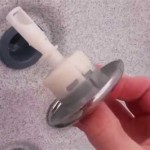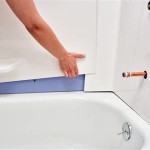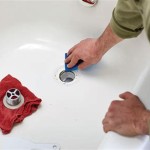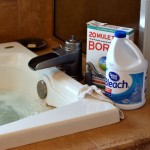How To Take The Drain Plug Out Of Bathtub
Removing a bathtub drain plug may seem like a simple task, but various types of plugs and installation methods can complicate the process. Understanding the different types of drain plugs commonly used in bathtubs and employing the appropriate techniques for removal are crucial for successful completion of this task without causing damage. This article will provide a comprehensive guide to identifying and removing various types of bathtub drain plugs.
Identifying the Type of Bathtub Drain Plug
Before attempting to remove a bathtub drain plug, it is essential to identify the type of plug in question. Different drain stoppers have distinct mechanisms, and using the wrong approach could damage the plug, the drain, or both. Common types include: pop-up stoppers, lift-and-turn stoppers, toe-touch stoppers, trip lever stoppers, and stopper-less drains. Each type requires a unique removal process.
Pop-Up Stoppers: These stoppers are activated by a lever located on the overflow plate, usually positioned just below the faucet. When the lever is moved, it raises or lowers the stopper in the drain. The stopper itself is typically held inside the drain pipe by a linkage mechanism connected to the overflow plate.
Lift-and-Turn Stoppers: These stoppers feature a knob or handle on the top of the stopper. The stopper is opened and closed by lifting and then turning the knob. The turning action tightens or loosens the stopper against the drain opening.
Toe-Touch Stoppers: These stoppers operate by pressing down on the top of the stopper with a toe or finger. A single press closes the drain, and another press opens it. They are often sleek and flush with the drain when open.
Trip Lever Stoppers: Similar to pop-up stoppers, trip lever stoppers are also operated by a lever on the overflow plate. However, instead of a simple up-and-down motion, the lever usually pivots, pulling or pushing on a linkage to control the stopper.
Stopper-less Drains: Some modern bathtubs employ stopper-less drains, often referred to as grid drains. These drains lack a traditional stopper. Instead, they feature a grate or grid that prevents large objects from entering the drain while allowing water to flow freely. Removing debris from these drains typically involves simply lifting the grate.
Removing Common Types of Bathtub Drain Plugs
Once the type of drain plug is identified, the appropriate removal technique can be applied. Safety precautions, such as wearing gloves and eye protection, should be taken before beginning. It is also beneficial to have a container handy to collect any water or debris that may be released when the plug is removed.
Removing a Pop-Up Stopper:
1. Locate the overflow plate on the bathtub wall, typically below the faucet.
2. Unscrew the overflow plate. This will usually require a Phillips head screwdriver.
3. Carefully pull out the overflow plate and the attached linkage. The drain stopper will be connected to the bottom of this linkage.
4. Detach the drain stopper from the linkage. This may involve unscrewing a small screw or clip that holds the stopper in place.
5. Inspect the stopper for any hair or debris, and clean it thoroughly before reassembling or replacing the stopper.
Removing a Lift-and-Turn Stopper:
1. Locate the set screw on the side of the stopper knob. This screw is often small and may be hidden.
2. Use a small Allen wrench or screwdriver to loosen the set screw.
3. Once the set screw is loose, the stopper can be lifted straight out of the drain. It may require some gentle wiggling to dislodge any debris.
4. Clean the stopper and the drain opening thoroughly.
Removing a Toe-Touch Stopper:
1. Some toe-touch stoppers can be unscrewed directly. Try gripping the top of the stopper and turning it counterclockwise. If it unscrews, continue until it is completely removed.
2. If the stopper does not unscrew, it may require a different approach. Some toe-touch stoppers have a release mechanism inside the stopper body.
3. To access this mechanism, the top of the stopper may need to be pried off or unscrewed. Refer to the manufacturer's instructions if available.
4. Once the top is removed, there may be a screw or nut that needs to be loosened to release the stopper.
5. After loosening the screw, the stopper can be pulled out of the drain.
Removing a Trip Lever Stopper:
1. Similar to pop-up stoppers, begin by locating the overflow plate and unscrewing it.
2. Carefully pull out the overflow plate and the attached linkage. The drain stopper will be at the end of this linkage.
3. Examine the linkage and identify how the stopper is connected. It may be held in place by a clip, screw, or other fastener.
4. Detach the stopper from the linkage by removing the appropriate fastener.
5. Clean the stopper and the drain opening thoroughly before reassembling or replacing the stopper.
Removing a Stopper-less Drain or Grid Drain:
1. The removal for this one is the easiest of them all. For cleaning and removing debris, lift the grate or grid from the drain opening.
2. Clean the grate or grid and underneath the drain opening thoroughly.
Troubleshooting Difficult Drain Plug Removal
In some cases, removing a bathtub drain plug can be challenging. The plug may be stuck due to rust, corrosion, or accumulated debris. Applying gentle force and using penetrating oil can often resolve these issues. If excessive force is required, it is best to seek professional assistance to avoid damaging the drain or plumbing.
Stuck Drain Plugs: If the drain plug is stuck, apply a penetrating oil such as WD-40 or Liquid Wrench around the base of the plug. Allow the oil to sit for several minutes to loosen any rust or corrosion. Then, gently try to wiggle and lift the plug out of the drain. Avoid using excessive force, which could damage the drain or the plug itself.
Corroded Parts: Corrosion can make it difficult to remove screws or fasteners. If a screw is corroded, try spraying it with penetrating oil and allowing it to soak for a while. Use a properly sized screwdriver to avoid stripping the screw head. If the screw is severely corroded, it may need to be replaced.
Broken Linkage: If the linkage connecting the overflow plate to the drain stopper is broken, it may be difficult to remove the stopper. In this case, it may be necessary to use a pair of needle-nose pliers to reach down into the drain and manipulate the stopper. It may also be necessary to disassemble the overflow plate and linkage to gain better access to the stopper.
Specialized Tools: For stubborn drain plugs, specialized tools such as drain plug removal wrenches or extractors can be helpful. These tools are designed to grip the drain plug securely and provide leverage for removal. They are available at most hardware stores.
Professional Assistance: If all else fails, contacting a professional plumber is recommended. Plumbers have the expertise and tools necessary to remove difficult drain plugs without causing damage. They can also identify and address any underlying plumbing issues that may be contributing to the problem.
Understanding the specific type of drain plug and employing the correct removal technique are crucial for successfully completing this task. Applying patience, using the appropriate tools, and seeking professional help when needed will ensure the job is done safely and effectively.

How To Easily Remove Bathtub Drain Plug Stopper Unclog In 1 Minute Jonny Diy

Remove A Bathtub Drain Stopper To Unclog The Quick Easy

4 Easy Ways To Remove A Tub Drain Stopper Wikihow
:max_bytes(150000):strip_icc()/remove-tub-stopper-clear-a-drain-2718786-06-b651d62bfb29494a824821126579e750.jpg?strip=all)
How To Remove 6 Diffe Kinds Of Drain Stoppers

How To Remove Bathtub Drain Stopper That Spins Freely
:max_bytes(150000):strip_icc()/remove-tub-stopper-clear-a-drain-2718786-hero-425b2598739f43718b6905767d2616d8.jpg?strip=all)
How To Remove 6 Diffe Kinds Of Drain Stoppers

How To Remove A Bathtub Drain The Home Depot

How To Remove A Bathtub Drain Stopper

So Easy How To Remove A Watco Pop Up Drain Plug

How To Remove A Bathtub Drain Stopper Mr Rooter








